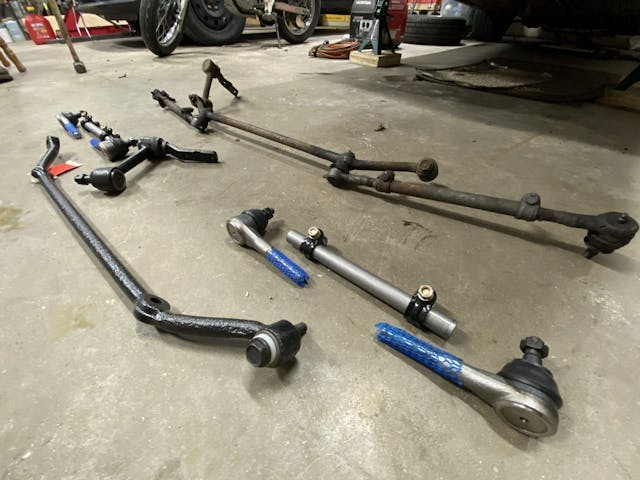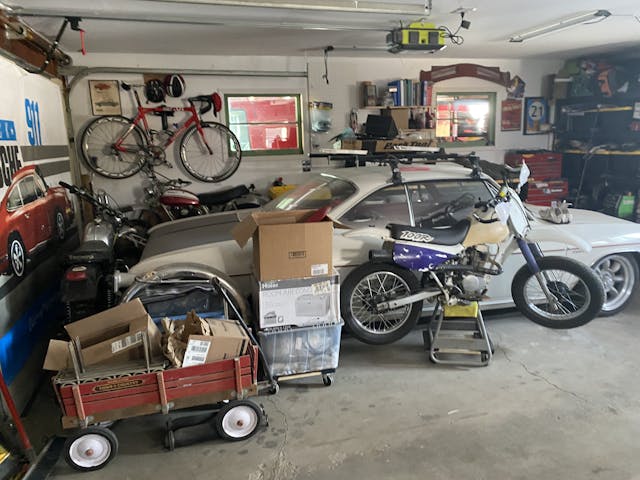Media | Articles
Keeping the Corvair project tracking straight turned out easy
Garages are often like dress pants. You buy what seems like the perfect fit and when the time comes to use them they are too small. You don’t have that problem? Only me? I don’t believe you, but okay. The latest example of my space constraints has been getting the 1965 Chevrolet Corvair steering repaired. With winter in full swing the garage has packed on the pounds and is stretching the belt holes holding it all in.
For starters, there is the ever present agreement with the missus that her daily driver parks inside during the snowy season. That immediately kicks one of the vintage cars to offsite storage. Mix in seven motorcycles, two workbenches, a rolling toolbox, and enough storage to make up for not having a basement and suddenly it’s a wonder I am able to work on anything at all. It seems to be a game of shuffling things away from whatever I want to work on and then shuffling the piles back when I’m done. Not ideal, but functional.
The Corvair has been a focus of mine as the Six Ways to Sunday project has been winding down. I finally have time to wrench on something other than my Honda XR250R and the Corvair has been in need of some love. The interior still needs finish work, but the real focus for me has been getting it road-ready so I can drive it more this summer. The Corvair has been sitting idle for at least two years because I had grand plans to fabricate an exhaust and that took years to finish. When I finally did wrap that up, a trip to the alignment shop let me know the steering gear was pretty shabby. No problem, that should be a one-Saturday job.
And it was. Seriously. I cannot overstate how much I love southern cars. A few years back the whole front suspension came out for a rebuild and refresh but I left the steering gear in place because it was okay at the time. I’ve never broken a bolt disassembling this car and that is saying something. A set of quick-ratio steering arms was the only change during the last front end service, and the alignment shop that put it back to square when the crossmember and suspension got reinstalled didn’t call out anything that needed attention. The car was driven hard before my ownership, so it’s really not surprising that the steering was loose.
To be exact, the pitman arm bushing and idler arm had too much play. When I started investigating parts ordering I found that the best use of my time was to spend more money and purchase a drag link (the piece that connects the idler arm and pitman arm, and also transfers motion to the tie rods) with a new pitman arm bushing installed. This would mean there would he no need to ream the bushing to size and press it into place. That also meant I would need to package up the drag link from my car and return it as a core for Clark’s Corvair to refurbish and sell to the next enthusiast in my same situation. I typically like to hoard my spare parts, but I also like to see Corvairs stay on the road so cores are pieces I will happily send back in an effort to keep cars driving.
Marketplace
Buy and sell classics with confidence
Considering the grime on everything, it all came apart easily. I used the crusty old tie rods to ballpark size the new ones before going through and bolting everything back together. In the world of working on old cars this is actually an easy job: unbolt old stuff, bolt on new stuff. The only change was a piece that needed help from the welder before going together.
That drag link I purchased from Clark’s Corvair was originally designed by GM engineers for skinny little 13-inch bias ply tires, not the modern sticky 17-inch steamroller rubber I have bolted on. Taking a cue from the Corvair autocross and racing community, I elected to burn some welding wire and attach a brace to keep the drag link from flexing. Will I truly notice the difference this will make? Probably not, but for the cost of some angle iron and welding wire I can rest assured the effort I put into the steering wheel will reach the tires.
The last little change was to get rid of the quick steering arms in favor of a different set of quick steering arms. The problem with the factory-style arms are the Ackerman angle being decidedly not good. Ackerman angle means as the wheels are turned, the one on the inside of the turn makes a sharper angle than the outer tire. Some Ackerman is a good thing, but too much causes scrubbing and odd handling. This new set comes from a Corvair enthusiast who took the time to do all the design to solve the Ackerman problem while keeping the ratio quicker than stock. I’m not the first to install them, but am still on the testing end of things. For starters I will need to fabricate steering stops before I get too excited about driving, but that is a small thing that I will kick down the road for now.
With anti-seize applied liberally and everything torqued to spec, I set the car down and roughed in the toe adjustment with a tape measure. The car is ready for the drive to the alignment shop now, but it’s going to have to wait until the true spring thaw and a few good hard rains before that can happen. The salt is heavy on the asphalt currently and I’ve got other projects to get to. After all, the garage is bursting at the seams.
























Hey, if the steering arms worked out, could you let us know who you bought them from?
Cheers